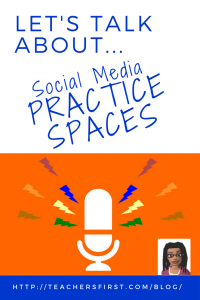 I have been an advocate for the use of social media in schools for a long time. As a professional, using social media is a great way to learn and grow and connect with others who are like-minded. While social media can be a great tool, we’ve all heard of people who used social media unwisely and as a result, had to face real consequences. Many teachers use these types of situations as an excuse not to get involved with social media. In my mind, these incidents really tell us the reason why we as teachers need to dedicate time to learn about social media. We can’t prepare our students to use it wisely if we don’t understand social media ourselves.
I have been an advocate for the use of social media in schools for a long time. As a professional, using social media is a great way to learn and grow and connect with others who are like-minded. While social media can be a great tool, we’ve all heard of people who used social media unwisely and as a result, had to face real consequences. Many teachers use these types of situations as an excuse not to get involved with social media. In my mind, these incidents really tell us the reason why we as teachers need to dedicate time to learn about social media. We can’t prepare our students to use it wisely if we don’t understand social media ourselves.
Sir Ken Robinson tells us that we need to prepare students for jobs that don’t yet exist. As teachers, we have a responsibility to prepare them as best we can. Breaking down professional activities can help us know what students will need to be able to do as professionals, even if we do not know what the content would be. If we take a future-looking framework, like Michael Fullan’s 6Cs, we can see what skills our students might need in order to be ready for employment in the future: Character Education, Citizenship, Communication, Critical Thinking and Problem Solving, Collaboration and Creativity. Social media is an engaging way to practice these skills.
Many of our students are too young to use social media according to the terms of service for most platforms, so how do we accomplish this? Create and use practice spaces! Practice spaces can allow our students to learn the skills they need to without the worry of exposing them to adult social media. Practice spaces also allow students to make and learn from their mistakes without the eyes of the world watching them. What is a social media practice space? Glad you asked! I like to categorize them into three groups: no-tech, low-tech and high-tech.
Yes, you can have a no-tech social media practice space. They are best used by teachers working with students in primary grades, with little access to technology (i.e., weekly computer lab rotation), or who don’t really use social media themselves. Students can use printed templates, paper blog posts, or work from a projected image. These may appear limiting and forced with older students, but they are an excellent way to begin conversations about critical thinking, message clarity, and representing yourself online.
Allowing students to use technology to create simulated social media posts is a low-tech option. These are helpful for elementary students, students in alternative educational programs, and those with limited access to technology (i.e., a few computers in the room). Students could use the Classtools’ Fakebook generator (reviewed here) or Twister (reviewed here). It is easy to make (or borrow) templates in PowerPoint online or Google Slides. Here is a Twitter template and an Instagram template.
High-tech practice spaces are platforms that allow for real-time sharing and commenting. If your students are older, have liberal access to technology, or if you are comfortable with social media, then this option is for you. SearchTeam (reviewed here) is one of my all-time favorites. I also like “community” sites like Bookopolis (reviewed here), Write the World (reviewed here) and MySciLife.
Using social media to practice workplace readiness skills will be very helpful to our students and their future employers. Getting started might seem a little daunting, but the outcome will be totally worth the effort.


Yes, Sir! Students can learn a lot from their mistakes in social media practice space because the world is not watching them.
I absolutely love this and agree! Let’s not ban the tool but teach them! Thank you for these resources!